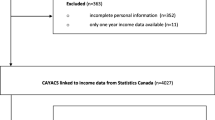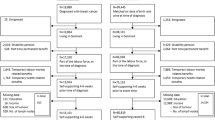Abstract
Aims
This study seeks to assess the impact of breast cancer on survivors’ annual income at 1 to 13 years of follow-up.
Methods
A Norwegian registry-based dataset with a 13-year follow-up period was used. The dataset contained case–control pairs, where each pair consisted of one breast cancer case and a cancer-free control, matched for age, marital status, and municipality of residence. A mixed linear model was used to analyse the average income development for cases and controls adjusting for available demographic variables not used in the matching procedure, such as education level, immigration history, and number of children. Individual income was only considered relevant for cancer survivors, thus case–control pairs were censored upon death. Income development by stage of tumour at time of diagnosis was also assessed.
Results
The income of breast cancer survivors had reduced immediately following diagnosis. At 1 year after diagnosis, income development between cases and controls became significantly different (p = 0.006). Differences increased slightly but remained significant throughout the follow-up period. At 13 years after diagnosis, the estimated cumulative income loss for survivors was 39.403 € (p < 0.001). The income development of stage I breast cancer patients was similar to their controls. For higher stage breast cancer patients, the income differences were more pronounced but not always statistically significant.
Conclusions
Breast cancer has a significant negative effect on the individual incomes of survivors, even at 13 years after diagnosis. Effects increased for individuals with more advanced cancer stages.
Implications for Cancer Survivors
In Norway, breast cancer survivors experience lower income than their cancer-free controls. This may indicate a need for financial compensations in order to maintain the standard of living for this group of patients.


Similar content being viewed by others
References
Cancer in Norway 2010. Cancer incidence. Mortality, survival and prevalence in Norway. 2010 (http://www.kreftregisteret.no/Global/CIN_2010.pdf)
Rayce SL, Christensen U, Hougaard CØ, Diderichsen F. Economic consequences of incident disease: the effect on loss of annual income. Scand J Publ Health. 2008;36:258–64.
Syse A, Tønnessen M. Cancer’s unequal impact on incomes in Norway. Acta Oncol. 2012;51:480–89.
Syse A, Tretli S, Kravdal Ø. Cancer’s impact on employment and earnings – a population-based study from Norway. J Cancer Surviv. 2008;2:149–58.
Hauglann B, Šaltytė Benth J, Fosså SD, Dahl AA. A cohort study of permanently reduced work ability in breast cancer patients. J Cancer Surviv. 2012;6:345–56.
Eaker S, Wigertz A, Lambert PC, Bergkvist L, Ahlgren J, Lambe M. Breast cancer, sickness absence, income and marital status. A study on life situation 1 year prios diagnosis compared to 3 and 5 years after diagnosis. PLoS ONE. 2011;6:e18040.
Larsen IK, Småstuen M, Johannesen TB, Langmark F, Parkin DM, Bray F, et al. Data quality at the Cancer Registry of Norway: an overview of comparability, completeness, validity and timeliness. Eur J Cancer. 2009;45:1218–31.
Declaration of conflicting interests
The authors declare that there is no conflict of interest.
Author information
Authors and Affiliations
Corresponding author
Appendix A: Mathematical formulation of the model
Appendix A: Mathematical formulation of the model
The data were organized in pairs of matched cases and controls. The index i was used to identify such a pair.
Define I i,j as the income for the case of pair i, j years after diagnosis, where j ∈{-1,0,1,2…}. The income development j years after diagnosis was calculated as ∆ i,j = I i,j − I i, − 1. Similarly, define \( {\widehat{I}}_{i,j} \) as the income of the cancer-free control of pair i, j years after the diagnosis of the corresponding case, and let \( {\widehat{\varDelta}}_{i,j}={\widehat{I}}_{i,j}-{\widehat{I}}_{i,-1} \) be income development.
Define \( {Y}_{i,j}={\varDelta}_{i,j}-{\widehat{\varDelta}}_{i,j} \), the difference in income development j years after diagnosis, between pair i’s case and control. It represents the advantage that pair i’s cancer free control has over the corresponding breast cancer patient, corresponding to increase of income since one year prior to diagnosis.
Define the following linear regression equation for Y i, j :
Here, α is a constant term and βj, j ∈ {−1,0,1,2, …}is the effect that the number of years after diagnosis has on Y. These are the primary parameters, interpreted as the effect that the cancer diagnosis has had on the case’s income development, j years after diagnosis. The pre-diagnosis year (−1) was used as reference category.
The parameters γα(i), α ∈ {44,45, …,67} represent the effect that the pair’s age at the time of income has on Y. Youngest women (age 44 in the pre-diagnosis year) were used as reference group. Age may have a non-linear relation to income development and is therefore included in to the model as confounder. The vectors x i and \( \widehat{x_i} \) represent level of education, immigration history, and number of children for cases and controls, respectively. Here, the vectors x i and \( \widehat{x_i} \) represent confounding socio-demographic factors that were not used in the matching procedure. Parameter vectors for cases and controls are denoted by φ and \( \widehat{\varphi} \), respectively.
The error term is given as the sum δ i + ε i,j , where both δ i ∼ N (0, τ2) and εi, j ∼ N (0, σ2) are independently identically distributed. Here, δ i is a random error associated with pair i and is constant for all years j. It captures the clustering effect of correlated observations from the same pair i over time. The term ε i, j is a random error associated with each individually observed pair i at year j. This error structure represents multi-level modelling, with the pair as the clustering unit.
Note that the right-hand side of Equation (1) can be expressed in a standard form of a sum of parameters and predictors as follows:
Here, d j,j ′ is a dummy variable, equal to 1 if j = j ′, and 0 otherwise. Similarly, e i,j,α = 1, when pair i was of age α j years after diagnosis, and 0 otherwise.
In the model estimation, a combination i j of a pair i and number years j after diagnosis was only used if both the case and control were alive at that time.
Rights and permissions
About this article
Cite this article
Šaltytė Benth, J., Dahl, F.A., Lurås, H. et al. A controlled study of income development for breast cancer survivors in Norway. J Cancer Surviv 8, 239–247 (2014). https://doi.org/10.1007/s11764-013-0324-4
Received:
Accepted:
Published:
Issue Date:
DOI: https://doi.org/10.1007/s11764-013-0324-4




